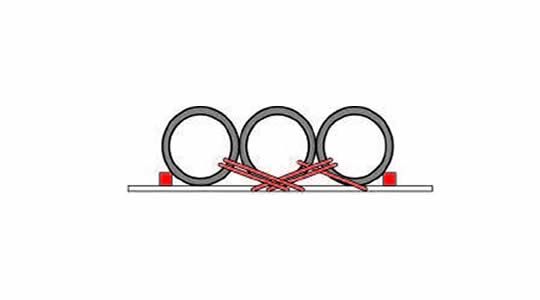Review Questions - Click On The Picture To Begin...

- It depends on the weight of the load.
- Front only.
- Rear only.
- Front and rear.
Quote From The CDL Manual:
Immobilize the front and rear pipe with on of the following methods:
- Blocking
- Wedges
- Vehicle end structure
- Stakes
- Locked pipe unloader
- Other equivalent means
- 45-90 degrees
- 45 degrees
- It doesn't matter
- 180 degrees
Quote From The CDL Manual:
If the first pipe of a group in the top tier is not at the front of the tier beneath:

Attach an additional tiedown that runs rearward at an angle not more than 45 to the horizontal when viewed from the side of the vehicle, whenever practical.
Pass tiedown either through the front pipe of the upper tier or outside the front pipe and over both longitudinal tiedowns.
- Straight up and down.
- It doesn't matter.
- Rearward
- Forward
Quote From The CDL Manual:
Requirements for securing the pipe
Secure each pipe with tiedowns through the pipe.
Run at least one tiedown through each pipe in the front half of the load. This includes the middle one if there are an odd number. The tiedown must run rearward at an angle not more than 45� with the horizontal when viewed from the side of the vehicle, whenever practicable.
Run at least one tiedown through each pipe in the rear half of the load. The tiedown must run forward at an angle not more than 45� with the horizontal when viewed from the side of the vehicle, whenever practicable. This holds each pipe firmly in contact with adjacent pipe.
- Straight up and down
- Forward
- Rearward
- It doesn't matter
Quote From The CDL Manual:
Requirements for securing the pipe
Secure each pipe with tiedowns through the pipe.
Run at least one tiedown through each pipe in the front half of the load. This includes the middle one if there are an odd number. The tiedown must run rearward at an angle not more than 45� with the horizontal when viewed from the side of the vehicle, whenever practicable.
Run at least one tiedown through each pipe in the rear half of the load. The tiedown must run forward at an angle not more than 45� with the horizontal when viewed from the side of the vehicle, whenever practicable. This holds each pipe firmly in contact with adjacent pipe.
- It depends on the weight of the pipe.
- 3
- 2
- 1
Quote From The CDL Manual:
Requirements for securing the pipe
Secure each pipe with tiedowns through the pipe.
Run at least one tiedown through each pipe in the front half of the load. This includes the middle one if there are an odd number. The tiedown must run rearward at an angle not more than 45� with the horizontal when viewed from the side of the vehicle, whenever practicable.
Run at least one tiedown through each pipe in the rear half of the load. The tiedown must run forward at an angle not more than 45� with the horizontal when viewed from the side of the vehicle, whenever practicable. This holds each pipe firmly in contact with adjacent pipe.









 TT On Facebook
TT On Facebook